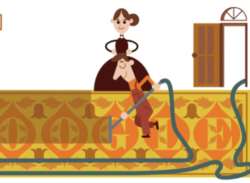Who is Hubert Cecil Booth? Why does Google remember him on 147th birth anniversary with a Doodle?
Google Doodle: Search Giant Google remembers the man who invented first powered vacuum cleaner, Hubert Cecil Booth, on his 147th birth anniversary.

Today, it is Hubert Cecil Booth’s turn in the spotlight as search giant Google dedicates a doodle to the man who gave the world it’s first powered vacuum cleaner. The English engineer, who would have been 147 years old today, was born in Gloucester in 1871.
Hubert Cecil Booth did his schooling at Gloucester College and Gloucester County School and then went to London to pursue civil and mechanical engineering from Central Technical College. He was always interested in engineering, so he became a student of Institution of Civil Engineers and also designed Ferris wheels, suspension bridges, and factories.
He was the first one who introduced powered vacuum cleaner. Before him, the earlier versions of the cleaning machines people used were just able to blow or brushed the dirt away, instead of sucking it up.
The first version of the vacuum cleaner that Booth invented was the first petrol-powered, horse-drawn vacuum cleaner relied upon air drawn by a piston pump through a cloth filter. The machine did all the work by suction through long tubes with nozzles on the ends, as it did not contain any brushes. Although the machine was very useful, the problem was it was too bulky to be brought into the building. However, its principles of operation were essentially the same as the vacuum cleaners we use today. Also, it was a horse-drawn vacuum cleaner, which added to its disadvantages.
Booth tried and tested many versions of his vacuum cleaner that were better than his previous ones. While people called his horse-drawn machine "Puffing Billy", he worked to improve it. His next vacuum cleaner was electric-powered, but it was still big to enter the buildings.
He never gave up and in the next few decades, Booth founded British Vacuum Cleaner Company (BVCC) which offered cleaning services. He was himself the Chairman and Managing Director of this company.
He went on to work on many more things. After the war, he built suspension bridges in Burma, India, and South Africa, and bridges for railway companies in Britain. He died on January 14, 1955, in Croydon, England.